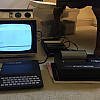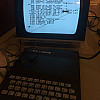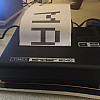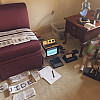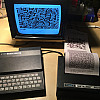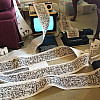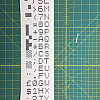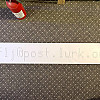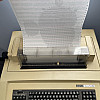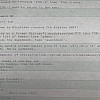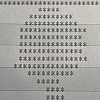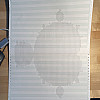PlatformStudies
These are creative coding projects inspired by Nick Montfort's Platform Poems. [1] Montfort uses specific vintage computing platforms in computational or process intensive works that are "less about data, the visualization of data, or multimedia effects" but instead explore code and symbol manipulation. I'm certainly drawn to symbol and data manipulation in my practice, whether it is generating images with type or printing digits of Pi. My goal here is to hack on early microcomputers by writing simple codes that do a small function or provide a measure of delight. Their limited capabilities create interesting constraints and more focus. On a personal level, I'm reconnecting with machines that were part of my early computing experiences, but in these projects, I return to a formative activity with more far more skill and insight. [2]
Timex Sinclair 1000
Banner
December 2019
A banner printing program implemented on the Timex Sinclair 1000 and 2040 thermal printer. Included below is a wav file of the recorded program. [3]
10 LPRINT
August 2019
A Timex Sinclair take on the classic 10 PRINT one-line BASIC program. Sinclair BASIC can't combine commands on a single line like other versions of the language. It also can't scroll the video display, but it can print endlessly on thermal paper.
ROM dump
December 2019
The thermal printer is used to image the 8K Timex Sinclair ROM and the smaller subset of video characters.
Apple II
Epimenides
September 2021
This one-line BASIC program is a concise version of the Liar Paradox.
10 CALL -8502
Minicomputers
Using historic software and hardware.
Printty Shop
Printing banner text using a Teletype Model 33 ASR connected to the Living Computer Museum DECDATASYSTEM 570, a rebadged PDP-11/70. The computer runs 7th Edition UNIX. The program banner(6) (/usr/games/banner) "reads the standard input and prints it sideways in huge built-up letters on the standard output." 7th Edition UNIX was released in 1979 and introduced significant changes to the OS, including greater portability for the rapidly growing minicomputer market.
Here, the Teletype uses a wifi232 modem to connect to a local Raspberry Pi by telnet. From the pi, a secure shell session connects to the host system. Printing the banner at 10 characters per second (the Teletype runs at 110 baud) takes about 15 minutes.
Mandelbrot
Generating the Madelbrot set in type. See also Mandelbrot.
Notes and references
- Nick Montfort, "A Platform Poetics / Computational Art, Material and Formal Specificities, and 101 BASIC POEMS," The Digital Review, September 12, 2021. https://thedigitalreview.com/issue01/montfort-a-platform-practice/index.html, retrieved June 26, 2022. doi: https://doi.org/10.7273/ba27-s438
- A little personal history: [4] My dad brought home our first computer in late 1982. He bought it used from a colleague and picked it up on a business trip. Hearing the car pull into the driveway, my mom, my sister and I eagerly dashed to the door to help him lug it in. A computer! When he stepped through with his briefcase and a small travel bag, we all asked where this new computer was. It was in his briefcase, he replied. This was our introduction to the Timex Sinclair 1000. I can admit now, that moment was a bit of a let down. To be fair, though, it did launch me on an amazing journey of tinkering with and programming computers. Thanks, Dad! //// At Christmas, we took the little computer on the road. We set it up at my grandparents' with a small black and white TV and my uncles and cousins took turns programming it or loading games and programs from cassette tape. I was one of the youngest in the family and was used to peering over the shoulders of others. I remember a collective effort to write a program that could generate dice rolls for a D&D character. Later at home, I would watch my dad putter around with the Timex Sinclair. He showed me some simple programming structures, like loops. The computer was on the floor of my parent's bedroom in front of their black and white TV. (The color TV was downstairs in the family room). //// That spring, I learned to program BASIC in school. There was one computer for grades K-8 in the school district -- a TRS-80 Model III. I had access to the machine every Monday when a few classmates and I took an accelerated studies course at the district's middle school. Eventually the little Timex Sinclair made it to my bedroom with a small, late 60's era black and white TV -- a discard from my great grandmother's house. For Christmas in 1983, I got the 2040 thermal printer. Throughout the year, I schemed to buy or acquire a more powerful computer. Apple II's were out of the question; they were much too expensive. [5] I spent hours looking through the Sears catalog at Atari computers or the ads in Compute! magazine. All the while, I wrote little programs on the limited and slow Timex Sinclair. //// Coming around 40 years later, the limitations of the Timex Sinclair are more endearing. It's easier now to appreciate the engineering and economizing that went into it and some of the feats that it's still capable of, despite using its processor to generate video.
- Timex Sinclair programs were stored on audio cassette tape.
- See also: Main.ThoughtsOnRestoration
- Our family did eventually buy an Apple //c in the fall of 1984. I still have that computer, too.

